Unappraisable Jewelry
Gemologist appraisers can detect many secrets about jewelry that are inaccessible to the rest of us. With their training, experience and gemological lab equipment, they determine the quality of gems and workmanship, and ultimately arrive at a valuation that insurers — and consumers — depend upon.
But sometimes an appraiser best serves his customer by just handing the jewelry back without appraising it. Here are some examples.
 1. A customer brought in for appraisal her grandmother’s treasured ruby ring. She’d been fascinated by the large red stone all her life and imagined the ring would be worth enough to pay off her house. But a quick glance through the microscope revealed the curved striae, or growth lines, that are clear evidence of a lab-grown stone. This synthesized ruby is worth considerably less than a natural gem.
1. A customer brought in for appraisal her grandmother’s treasured ruby ring. She’d been fascinated by the large red stone all her life and imagined the ring would be worth enough to pay off her house. But a quick glance through the microscope revealed the curved striae, or growth lines, that are clear evidence of a lab-grown stone. This synthesized ruby is worth considerably less than a natural gem.
Synthetic stones like this one have been produced since the late 1800s, so they are very easy for gemologists to spot. Gems made using today’s technology could be much more difficult to detect, as they more closely resemble natural gems. For such stones, the appraiser would have to remove the stone from its mounting and might have to send it to a lab to be thoroughly tested.
In this ring, which dated from the 1950s, the stone was obviously synthetic. The value of the ring came to less than the price of an appraisal.
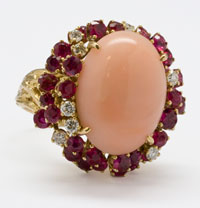 2. The centerpiece of the ring is coral. The surrounding stones include diamonds and two types of red stones. The appraiser could see that some of them had been replaced at one time. To accurately determine the ring’s value, each small stone would have to be removed, tested and then reset—all of which would add considerably to the cost of the appraisal. Some of the prongs might break when the stones were taken out, and repairing them would mean additional charges.
2. The centerpiece of the ring is coral. The surrounding stones include diamonds and two types of red stones. The appraiser could see that some of them had been replaced at one time. To accurately determine the ring’s value, each small stone would have to be removed, tested and then reset—all of which would add considerably to the cost of the appraisal. Some of the prongs might break when the stones were taken out, and repairing them would mean additional charges.
Without performing a detailed examination of the stones, the appraiser estimated that the ring would be worth no more than $1,200. To properly schedule the ring, all stones should be removed and tested, incurring high costs relative to the ring’s value.
The ring might simply be covered on a homeowners policy, but such coverage usually carries a significant deductible. With a deductible of $300-$500, the cost of appraising all the ring’s stones would still hardly be worthwhile.
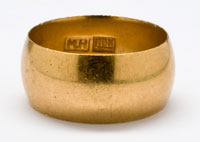 3. This simple gold band is stamped as 18 karat gold. But it is worn thin and the edges are jagged. It may have sentimental value but it has no value as jewelry. It is worth only the price of the scrap metal.
3. This simple gold band is stamped as 18 karat gold. But it is worn thin and the edges are jagged. It may have sentimental value but it has no value as jewelry. It is worth only the price of the scrap metal.
People often have a distorted sense of the value of gold, holding on to old jewelry because of its gold content. Even at today’s gold price of about $1,400 per ounce (a very high price, historically), the scrap value of this 5-gram gold ring would be $100.
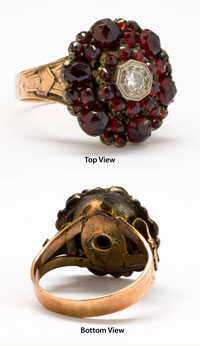 4. Here is an old ring that’s been repaired a few times. At first glance there appear to be a cluster of garnets surrounding a central diamond. It turns out this ring has several attributes that hinder a thorough examination.
4. Here is an old ring that’s been repaired a few times. At first glance there appear to be a cluster of garnets surrounding a central diamond. It turns out this ring has several attributes that hinder a thorough examination.
The red stones are believed to be garnets; a final determination would depend on their Refractive Index (RI) — one of the primary indicators gemologists use to determine what a stone is. To get an RI reading with a Refractometer, one of the stones must have an accessible flat surface that is unscratched, which this ring does not have. Since the back of the ring is closed, the appraiser also cannot measure the depth of the stones nor examine them for inclusions. If the appraiser were to remove the stones for examination, chances are he would damage the mounting and incur further costs for the customer.
In any case, garnets like these are very inexpensive. The appraiser could also tell that the center stone was not a diamond but probably colorless sapphire, also inexpensive. The jewelry’s estimated value is $250. Appraisal fees, plus the labor involved, would come to more than the ring is worth.
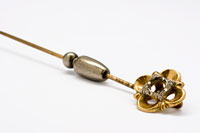 5. Here is another family heirloom, a karat gold stick pin. The stone had been removed some time ago and the prongs cut off.
5. Here is another family heirloom, a karat gold stick pin. The stone had been removed some time ago and the prongs cut off.
If it had sentimental value and the owner wanted to wear the pin, a stone could be added. New prongs and the setting fee would be about $150; plus an appraisal fee of $50-$125 depending on the stone; plus, of course, the cost of the gem. The pin has no karat stamp, so the gold content would have to be tested, entailing an additional fee.
As it is, this piece has no value as jewelry, since stick pins are out of fashion. The value of the scrap is about $30.
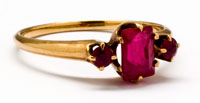 6. This looks like a ruby ring, having a large center ruby flanked by two smaller ones. It turns out the center stone is glass, since bubbles in it are easily visible to the gemologist. The smaller stones may or may not be rubies. In either case, the labor charges for removing them for examination and appraisal would exceed the value of the ring (estimated at $150).
6. This looks like a ruby ring, having a large center ruby flanked by two smaller ones. It turns out the center stone is glass, since bubbles in it are easily visible to the gemologist. The smaller stones may or may not be rubies. In either case, the labor charges for removing them for examination and appraisal would exceed the value of the ring (estimated at $150).
Why would a ring with real rubies have glass as the centerpiece? As our gemologist appraiser points out, jewelers are not necessarily gemologists. The jeweler may not even have known the center stone was glass. Or he may have used glass to deceive the customer. Or the original center ruby may have been lost and the owner couldn’t afford to replace it with genuine ruby.
All these examples are good arguments for the importance of having an appraisal from a graduate gemologist, preferably one who is also a Certified Insurance Appraiser™.
FOR AGENTS & UNDERWRITERS
Things are not necessarily as they appear. What a jewelry owner values as ruby may turn out to be glass, a “diamond” may be clear sapphire. Rely only on a detailed appraisal, such as JISO 78/79.
All scheduled jewelry should come with an appraisal from a GG, preferably one who is also a CIA™.
Unscheduled jewelry usually carries a significant deductible, which can be greater than the jewelry’s value. Claims for jewelry on a HO policy could also endanger the client’s HO claim-free status.
Most of our examples above were family heirlooms, pieces the customer assumed were valuable because they were old and treasured within the family. Such pieces have great sentimental worth, but insurers should always be aware that jewelry does not have value just because it is old.
Antique and period jewelry should be appraised by a gemologist who is familiar with this market. Even quality jewelry can have a low value if it is no longer in style.
FOR ADJUSTERS
Not all jewelers are trained gemologists.
For jewelry like the pieces discussed above, a less knowledgeable or less conscientious appraiser might have provided an appraisal based on a cursory look at the jewelry, without properly inspecting it.
Always scrutinize the appraisal and, if necessary, investigate the appraiser’s qualifications. Remember that appraising period jewelry requires an expertise beyond that of most jewelers dealing in contemporary pieces.
©2000-2025, JCRS Inland Marine Solutions, Inc. All Rights Reserved. www.jcrs.com

